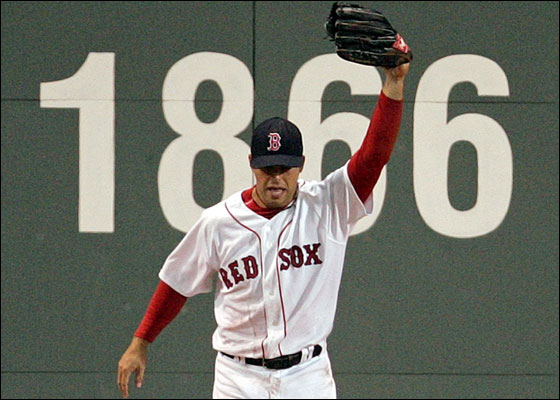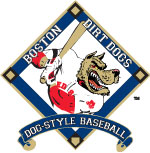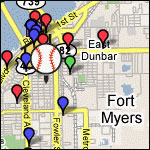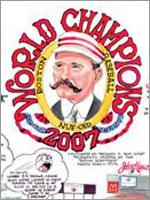
FARM REPORT by Gary Jacobs
5 Rules for Adam Stern
|

|
|
(Reuters Photo) |
JUNE 19, 2006 | PAWTUCKET - Adam Stern's first stint with the Red Sox was less than satisfying, for player and team, and everyone from Theo Epstein on down knew it. But based on the mysterious, multifaceted, and some would say unfair guidelines governing the Major League Baseball Rule 5 draft, if Stern didn't spend a full season with the Big Club, they couldn't keep him.
To sum up the Rule 5 draft in 30 words or less, if a player has four years' service (three if they were under 18 when he was drafted) and isn't protected in the Big Club's 40-man roster, he is eligible to be drafted in a winter draft. Stern wasn't protected by Atlanta, so the Red Sox plucked him from Atlanta's roster in 2004.
But there's always a wrinkle, and the Rule 5 draft has a doozy: Any team drafting a Rule 5 player has to keep that player on its major league squad for a full year, or be offered back to the original team for half the $50,000 draft fee. This rule effectively prevents the overuse, or misuse, of the draft by restricting the field to legitimate major-league prospects.
So when the Sox drafted Stern, they knew what they'd have to do: keep him riding the pine for a full season and hope that he could make a contribution.
It's not entirely unheard of for a Rule 5 pick to end up with a major league career, or even a Hall of Fame plaque: Pittsburgh made a smart Rule 5 pick with a kid named Roberto Clemente in 1954.
But Stern wasn't ready for prime time, and his numbers bore grim testament to it: in 16 plate appearances with the Sox over 36 games in 2005 he went an anemic 2 for 15 with no walks and one sacrifice, good for a .133 BA and .188 OBP. Stints on the DL and surgery to correct a labrum problem prevented him from getting any more of the at-bats the young player so desperately needed. As a result, he was optioned down to Pawtucket the day after he fulfilled his Rule 5 obligation. Conventional wisdom at the time was that four ABs a day every day would do the lad some good.
Since then Stern has spent just about every game in the PawSox lineup, usually at the leadoff spot (he gave it up for Coco Crisp during his one-game rehab stint here). And the work does seem to have improved his average, though probably not as much as the Brain Trust would like: Stern is batting .237 (49/207) in 50 games played. He's also using his speed to his advantage, as evidenced by his two bunt singles and two runs scored in a recent game against the Richmond Braves.
While he's pleased with his progress, he acknowledges that he's got a ways to go.
"Any time you lose a year, like last year I lost to injury, and you try to come back, you have to try to find your swing," said Stern one recent Sunday evening. "This year my swing has been inconsistent -- that's why you'll have good games and then you'll go on a bad streak. I'm just trying to find my swing right now, find my comfort zone, and as the season goes on -- hopefully not too late -- I'll find it."
So, in honor of the Rule 5 draft that brought him to the Sox, here's five rules for Stern to get promoted:
1. Bring the average up. .237 in Triple-A isn't going to cut it -- and will just barely cut it in the bigs as a fourth or fifth outfield guy. He admits that something isn't right with his swing, which is a good thing: it's not like he's reached the upper end of his talent. And while we're talking about his hitting, he also needs to…
2. Increase his slugging percentage. Teams are a lot more forgiving of someone who hits infrequently if he can clear the bases when he does connect. Stern's .357 SLG puts him in the middle of the PawSox pack, third among outfielders, behind David Murphy and Ron Calloway. Not bad, but again, it's not the bigs.
3. Stay healthy. His 2005 season started off on the wrong foot -- or should I say hand -- with a thumb injury that turned out to be a fracture on March 5. He injured his hamstring on his rehab assignment, further hampering his comeback efforts. He was finally given a clean bill of health in mid July and stayed healthy for about a month, but then jammed his injured thumb, earning him another stint on the DL and a rehab assignment. Any league-wide muttering that the Sox were exaggerating the extent of his injury was erased when, while down in Pawtucket, he felt pain in his shoulder, and needed arthroscopic surgery to correct his torn right labrum.
This year it's been so far, so good: he's spent no time on the DL for Pawtucket and has played in 50 of the 57 games he's been around for, and has no more aches and pains than the average ballplayer this time of year.
4. Improve against lefties. In his time in the bigs he had a grand total of one AB against left-handed pitchers; the book on Stern was that he was ineffective against them. But this liability already seems to be turned to an asset: as of June 14 (the most recent date his splits were updated) he was batting 24 points higher against lefties than righties (.262 versus .238).
5. Remember his plus tools. Stern is blessed with above-average speed and fields his position extremely well. His most memorable performances make use of his speed by legging out bunt singles, stealing bases, and keeping pitchers off-balance and preoccupied. And combining his speed with his defensive abilities can be electrifying: one of the most lasting images of Stern's tenure with the Big Club was in his penultimate game, when his improbable acrobatic catch of a dying quail against the Devil Rays this past April 18 saved the game for a scuffling Jonathan Papelbon.
"This year, I kind of got away from that a little bit," says Stern. "[But] I've been talking to [Mark Budaska,] the [Pawsox] hitting coach to utilize my speed a little more, start putting down the bunt a little more."
When -- and if -- he does reclaim his swing, he should be ready for the Show; his fielding and speed are already there. The Sox, when healthy, are a little heavy in the outfield, with Ramirez, Crisp, Nixon, Pena, and Harris -- to say nothing of up-and-comer David Murphy; but Stern has most of Harris' speed and even at this point in his development, all the bat that Harris brings.
If he doesn't end up with the Boston Big Club, he's got a major-league future ahead of him somewhere -- provided he follows the rules.















